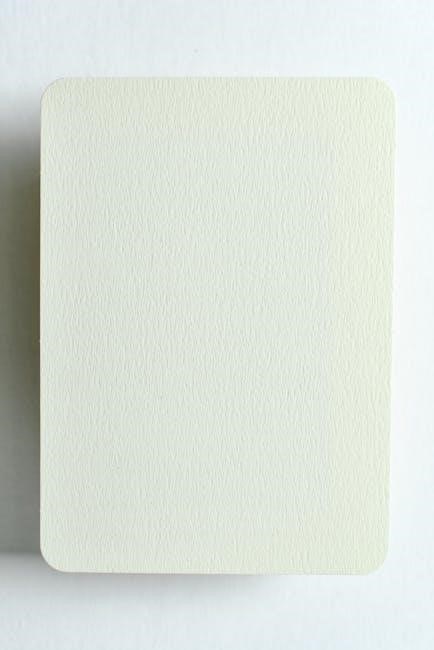A blank chord chart is a versatile tool for guitarists, providing a structured grid to create and visualize chords. It typically features string lines, fret markers, and a customizable layout, making it ideal for teachers, students, and songwriters. Available in formats like PDF, it’s perfect for printing and personalization.

Benefits of Using Blank Chord Charts
Blank chord charts offer versatility and customization, making them ideal for guitar teachers, students, and songwriters. They enhance learning, teaching, and creativity, while PDF formats ensure easy printing and sharing. These tools simplify chord organization and memorization, catering to diverse musical needs effectively.
For Guitar Teachers
Blank chord charts are an indispensable resource for guitar teachers, offering a flexible and customizable way to create structured lessons for students. Teachers can fill in the charts with specific chords, scales, or progressions, making them ideal for illustrating complex concepts in a visually organized manner. These charts allow for personalized learning, as instructors can tailor them to suit individual student needs or curriculum requirements. They also provide a clear framework for teaching chord shapes, finger placements, and string notes, helping students build a strong foundational understanding of guitar playing. Additionally, blank chord charts can be used to track progress, as teachers can fill them out with students over time to document their learning journey. The availability of these charts in PDF format makes them easy to print and distribute, ensuring that students have consistent reference materials. By using blank chord charts, teachers can create engaging, interactive, and effective lessons that cater to diverse learning styles and paces, fostering a deeper connection between students and their musical education.
For Guitar Students
Blank chord charts are an essential tool for guitar students, providing a clear and organized way to learn and practice chords. These charts allow students to visually map out chord shapes, finger placements, and string notes, making the learning process more intuitive. By filling out the charts with chords they are studying, students can reinforce their understanding and memorization of various chord positions. The charts are particularly useful for beginners, as they help in developing muscle memory and identifying patterns on the fretboard. Advanced students can also benefit by using them to explore complex chords or alternative tunings. The availability of blank chord charts in PDF format makes them easy to print and use during practice sessions. They also serve as a handy reference for reviewing lessons and tracking progress over time. With customizable layouts and the ability to focus on specific chords, blank chord charts empower students to take an active role in their learning, making the journey to mastering the guitar more engaging and effective.

For Songwriters and Composers
Blank chord charts are invaluable for songwriters and composers, offering a flexible canvas to explore and create musical ideas. These charts provide a structured format to sketch out chord progressions, experiment with harmonies, and visualize the harmonic foundation of a song. By mapping out chords in a blank chart, songwriters can freely innovate and organize their compositions without pre-defined constraints. Composers benefit from the ability to design complex arrangements, ensuring chord progressions align with the overall musical vision. The customizable layout allows for tailored notations, catering to unique chord voicings and intricate musical structures. Available in PDF formats, these charts are easily accessible for printing, making them a practical tool during creative sessions. They also serve as a reliable means to brainstorm and organize ideas, helping to maintain clarity and order in the creative process. Blank chord charts thus empower songwriters and composers to bring their musical concepts to life with precision and creativity, fostering innovation and artistic expression.

How to Choose the Right Blank Chord Chart
When selecting a blank chord chart, consider the number of strings, diagrams per page, and intended use. Ensure it aligns with your instrument type, whether for teaching, learning, or songwriting, and choose formats like PDF for easy customization and printing.
Considering the Number of Strings
When selecting a blank chord chart, it’s essential to consider the number of strings on your instrument. Most charts are designed for standard 6-string guitars, but options are also available for 7-string guitars, bass guitars (4 or 5 strings), and ukuleles (4 strings). Using a chart that matches your instrument ensures accuracy and prevents confusion. For example, a 6-string chart won’t work for a ukulele, as the tuning and string layout differ significantly. Additionally, bass guitar charts often require more space due to the lower pitch and wider string spacing. Choosing the right chart for your instrument guarantees that chord shapes and finger placements are represented correctly. This consideration is especially important for beginners, as it helps them learn proper techniques and avoid bad habits. Many websites offer blank charts tailored to specific instruments, so it’s worth exploring options that align with your needs. By matching the chart to your instrument, you can focus on learning and playing without unnecessary complications.
Selecting the Right Number of Diagrams per Page
Selecting the right number of diagrams per page is crucial for optimizing the use of blank chord charts. Charts are available with 16, 25, 36, or 49 diagrams per page, catering to different needs. For beginners, a page with fewer diagrams (e.g., 16) provides a clean, uncluttered space to focus on individual chords without overwhelming. Advanced players or those needing to reference multiple chords at once may prefer charts with more diagrams (e.g., 36 or 49), allowing for comprehensive chord libraries in a single view. Teachers often appreciate higher diagram counts for creating comparative lessons or showcasing variations of similar chords. Conversely, songwriters might opt for lower diagram counts to isolate and explore specific chord progressions. The layout should align with the user’s purpose, whether it’s for learning, teaching, or composition. Customizable templates enable further tailoring to suit individual preferences, ensuring the chart remains a practical and efficient tool. Balancing clarity and utility is key to maximizing the effectiveness of blank chord charts.
Determining the Purpose of Use
Determining the purpose of use is essential when selecting or creating a blank chord chart. This ensures the chart meets specific needs, whether for teaching, learning, or composing music. For guitar teachers, charts are often used to create structured lessons, making complex chords easier to understand. Students benefit from charts tailored to their skill level, helping them practice and memorize chords systematically. Songwriters and composers use blank charts to experiment with chord progressions, jot down ideas, and visualize harmonies. The purpose also influences the level of detail required, such as including string notes, fret markers, or additional space for annotations. By aligning the chart’s design with its intended use, users can maximize efficiency and creativity. Whether it’s for education, practice, or artistic expression, a well-defined purpose ensures the blank chord chart becomes a valuable and practical tool.

Steps to Create a Blank Chord Chart
Creating a blank chord chart involves defining the grid layout, adding string lines, and incorporating fret markers. Customize the design based on the intended use, ensuring clarity and functionality; Use tools like graphic design software or specialized music programs to achieve a professional look.
Defining the Grid Layout
Defining the grid layout is the first step in creating a blank chord chart. The grid typically consists of horizontal lines representing the frets and vertical lines representing the strings. For a standard guitar, the grid will have six vertical lines (for the six strings) and a variable number of horizontal lines, depending on how many frets you want to include. Ukulele charts, with four strings, will have four vertical lines. The grid should be clearly aligned and evenly spaced to ensure readability. When designing for PDF formats, consider the page size and margins to fit the grid properly. Some templates offer pre-defined grids, but you can also customize them to suit specific needs, such as including only the first few frets for beginners or extending the grid for advanced players. The grid layout sets the foundation for the entire chart, so it’s important to ensure accuracy and consistency from the start. This structure allows users to fill in chords easily, making the chart functional and user-friendly for teaching, learning, or songwriting purposes.
Adding String Lines and Frets
Adding string lines and frets is a critical step in creating a blank chord chart. The vertical lines represent the guitar strings, while the horizontal lines depict the frets. For a standard 6-string guitar, six vertical lines are drawn, corresponding to the low E, A, D, G, B, and high E strings. Ukulele charts, with four strings, will have four vertical lines. The horizontal lines are spaced evenly to represent each fret, typically starting from the nut (open strings) and extending upward. The number of frets included depends on the chart’s purpose, with some covering the first 4-5 frets for beginners and others extending to 12 or more frets for advanced players. Fret markers are often added at specific intervals (e.g., 3rd, 5th, 7th, and 12th frets) to guide musicians. The intersection of string and fret lines forms a grid where chord shapes can be visually represented. Proper alignment and spacing are essential to ensure clarity. When creating a PDF, these lines should be crisp and well-defined for optimal print quality. This step ensures the chart is functional and visually intuitive for users to fill in their chords.
Incorporating Fret Markers
Incorporating fret markers is essential for providing clear reference points on a blank chord chart. These markers are typically placed at specific fret positions to guide musicians in navigating the fretboard. Standard markers are often located at the 3rd, 5th, 7th, and 12th frets, corresponding to common chord shapes and intervals; For example, the 3rd fret marker helps identify chords like G major, while the 7th fret is useful for advanced techniques. Some charts include additional markers at the 2nd, 4th, 6th, and 9th frets for further precision. These markers can be simple dots or numbers, depending on the design. When creating a blank chord chart, fret markers should be evenly spaced and aligned with the string lines to ensure accuracy. Optional markers can also be added to highlight key areas for specific songs or techniques. This feature enhances the chart’s functionality, making it easier for users to visualize and play chords correctly. By incorporating fret markers, the chart becomes a more intuitive tool for learning and teaching guitar. Proper placement ensures that chord diagrams are clear and easy to follow, whether for beginners or experienced players.
Customizing the Design
Customizing the design of a blank chord chart allows users to tailor it to their specific needs and preferences. This can include adjusting the layout, font size, and color scheme to enhance readability. Many templates offer the option to add personalized notes, logos, or branding, making them ideal for teachers or professional musicians. The design can also be modified to focus on specific areas, such as highlighting certain strings or frets for beginner-friendly diagrams. Some blank chord charts include pre-designed themes that cater to different musical genres or playing styles. Additionally, users can experiment with grid sizes and spacing to ensure the chart is visually appealing and easy to follow. Customization options are particularly useful for educators, as they can create visually consistent materials for their students. Whether for personal use or professional purposes, a well-designed blank chord chart becomes a powerful tool for learning, teaching, and composing music. The ability to customize ensures that the chart remains versatile and adaptable to various musical contexts and goals. This flexibility makes blank chord charts indispensable for guitarists at all skill levels.

Popular Formats for Blank Chord Charts
Blank chord charts are widely available in formats like PDF, ensuring high-quality printing and easy sharing. Other popular formats include printable sheets, downloadable files, and editable templates in Word or Excel, offering flexibility for customization and digital use.
PDF Format
The PDF format is one of the most popular choices for blank chord charts due to its universal compatibility and high-quality print resolution. PDFs are widely used because they can be easily downloaded, shared, and printed without losing any formatting or clarity. Many websites offer free downloadable PDF templates for blank chord charts, catering to both standard 6-string guitars and alternative instruments like 7-string guitars, bass, or ukulele.
One of the key advantages of PDFs is their versatility. They often come in various layouts, ranging from 16 to 49 chord diagrams per page, allowing users to choose the design that best suits their needs. Additionally, PDFs are ideal for teachers and students, as they can be filled out by hand or edited digitally using software like Adobe Acrobat. This makes them a practical tool for creating custom chord sheets tailored to specific lessons or songs.
Furthermore, PDF files are lightweight and easy to store, making them accessible even on mobile devices. Many PDF blank chord charts include features like string notes and fret markers, providing a clear and organized structure for learning and teaching. Overall, the PDF format remains a preferred choice for musicians due to its convenience, flexibility, and professional presentation.
Other File Formats
Beyond PDF, blank chord charts are available in various other file formats to accommodate different needs and preferences. Image formats like PNG, JPEG, and SVG are popular for their high-quality visuals and ease of sharing across digital platforms. These formats are ideal for quick reference or embedding in websites and presentations. Additionally, editable formats such as Microsoft Word (.docx) or Excel (.xlsx) allow users to customize layouts, add notes, or modify diagrams directly. For those who prefer simplicity, text-based formats like .txt are also available, offering a lightweight and easy-to-edit option.
Some musicians and educators opt for formats like .docx or .odt, which enable them to personalize chord charts with specific instructions or annotations. Meanwhile, graphic designers might favor SVG files for their scalability and precision in creating custom layouts. Overall, these alternative formats provide flexibility, catering to diverse preferences and use cases, whether for teaching, learning, or composing music.

Tools and Software for Customizing Blank Chord Charts
Customizing blank chord charts is made easier with a variety of tools and software. For graphic design enthusiasts, programs like Adobe Illustrator or GIMP allow precise control over layouts, fonts, and visuals. Microsoft Word and Excel are popular choices for creating and editing chord charts, offering templates and customization options. Online tools like Canva provide user-friendly interfaces for designing visually appealing charts without advanced design skills.
For musicians, software like Guitar Pro or specialized chord diagram generators enables the creation of accurate and scalable chord charts. These tools often include libraries of chord shapes and fretboard visuals, making it easy to design charts tailored to specific songs or lessons. Additionally, some websites offer interactive chord chart builders that export designs in formats like PDF or PNG. Whether you’re a teacher, student, or songwriter, these tools empower you to create professional-looking chord charts that meet your unique needs.

Many of these tools are free or low-cost, making them accessible to everyone. They provide flexibility and creativity, ensuring that blank chord charts can be adapted for any musical purpose.

How to Effectively Use Blank Chord Charts
Blank chord charts are invaluable for organizing and visualizing guitar chords. Use them to map out chord progressions, practice transitions, or create custom lessons. They’re ideal for teaching, learning, or songwriting, allowing you to tailor your practice to specific musical goals.
- Organize chords by key or type for easy reference.
- Mark frequently used chords for quick access.
- Customize layouts to suit your playing style or teaching needs.
Regular use enhances muscle memory and theoretical understanding, making them a powerful tool for all guitarists.
For Teaching Guitar Lessons
Blank chord charts are an invaluable resource for guitar teachers, offering a flexible and customizable way to create structured lessons. Teachers can fill in the charts with specific chords, scales, or progressions tailored to individual students’ needs, ensuring a personalized learning experience. This tool is particularly useful for introducing new chords or reinforcing complex finger placements, as it provides a clear visual aid for students to reference.
The charts also allow teachers to organize lessons thematically, such as focusing on chords within a specific key or genre. By using blank chord charts, educators can help students gradually build their chord vocabulary and improve their understanding of chord relationships. Additionally, these charts can be used to map out chord progressions for songs, making it easier for students to practice transitions between chords smoothly.
Available in PDF format, blank chord charts are easy to print and distribute, ensuring students have a consistent reference for practice at home. They also serve as a valuable tracking tool, allowing teachers and students to monitor progress over time. This practical approach enhances engagement and helps students develop a strong foundation in guitar playing.
For Learning and Practicing Guitar
Blank chord charts are an essential tool for guitarists at all skill levels, providing a practical way to learn and practice chords effectively. These charts allow learners to map out chord shapes, finger placements, and progressions, making complex concepts more accessible. By filling in the charts, guitarists can create a personalized reference guide tailored to their learning goals.
Using a blank chord chart PDF, players can focus on specific chord types, such as major, minor, or seventh chords, and practice switching between them smoothly. This visual approach helps build muscle memory and improves finger dexterity. Additionally, the charts can be used to track progress, as learners can mark off chords they’ve mastered and identify areas needing improvement.
For beginners, blank chord charts are particularly useful for memorizing basic chord shapes and understanding their structure. Advanced players can use them to explore alternate tunings or complex chord voicings. The ability to customize and print these charts makes them a versatile resource for both practice sessions and performances.
Overall, blank chord charts provide a hands-on, interactive way to enhance guitar skills, fostering a deeper understanding of chord construction and application.
For Songwriting and Composition
Blank chord charts are invaluable for songwriters and composers, offering a flexible canvas to explore and document musical ideas. These charts provide a structured way to map out chord progressions, experiment with substitutions, and visualize harmonic relationships. By sketching chord shapes and sequences, creators can develop a clear framework for their compositions.
Using a blank chord chart PDF, songwriters can easily experiment with different chord voicings and arrangements, ensuring their progressions are both unique and effective. The charts also serve as a tool for organizing ideas, allowing composers to plan out entire sections of a song, from verses to choruses, in a coherent manner.
Additionally, blank chord charts encourage creativity by providing space to explore alternate tunings or unconventional chord shapes. They are particularly useful for those who prefer a hands-on approach to composition, as they can physically fill in chords and see how they interact within a progression.
Whether crafting a simple melody or a complex arrangement, blank chord charts empower songwriters to bring their ideas to life with clarity and precision. Their versatility makes them an essential resource for musicians aiming to refine their compositional skills.

Tips for Maximizing the Use of Blank Chord Charts
To get the most out of blank chord charts, start by organizing them in a way that suits your workflow. For guitar teachers, use different colors or symbols to highlight key chords or progressions, making lessons more engaging for students. For songwriters, experiment with filling in chords for entire songs, using the charts to visualize transitions and refine harmonic structures.
Practice regularly by filling out charts with new chords or scales, focusing on muscle memory and accuracy. For students, use blank charts to create flashcards or quizzes, reinforcing chord recognition and placement. Teachers can also use them to design personalized exercises tailored to individual learning needs.
When composing, use blank charts to sketch out chord progressions and explore variations. This helps in identifying patterns and improving the flow of your music. Additionally, keep a collection of completed charts for reference, allowing you to revisit and build upon previous ideas.
Finally, customize your charts by adding notes, lyrics, or tempo markings to make them more comprehensive. Regularly review and update your charts to track progress and refine your skills. By leveraging these strategies, blank chord charts become a powerful tool for learning, teaching, and creating music.
